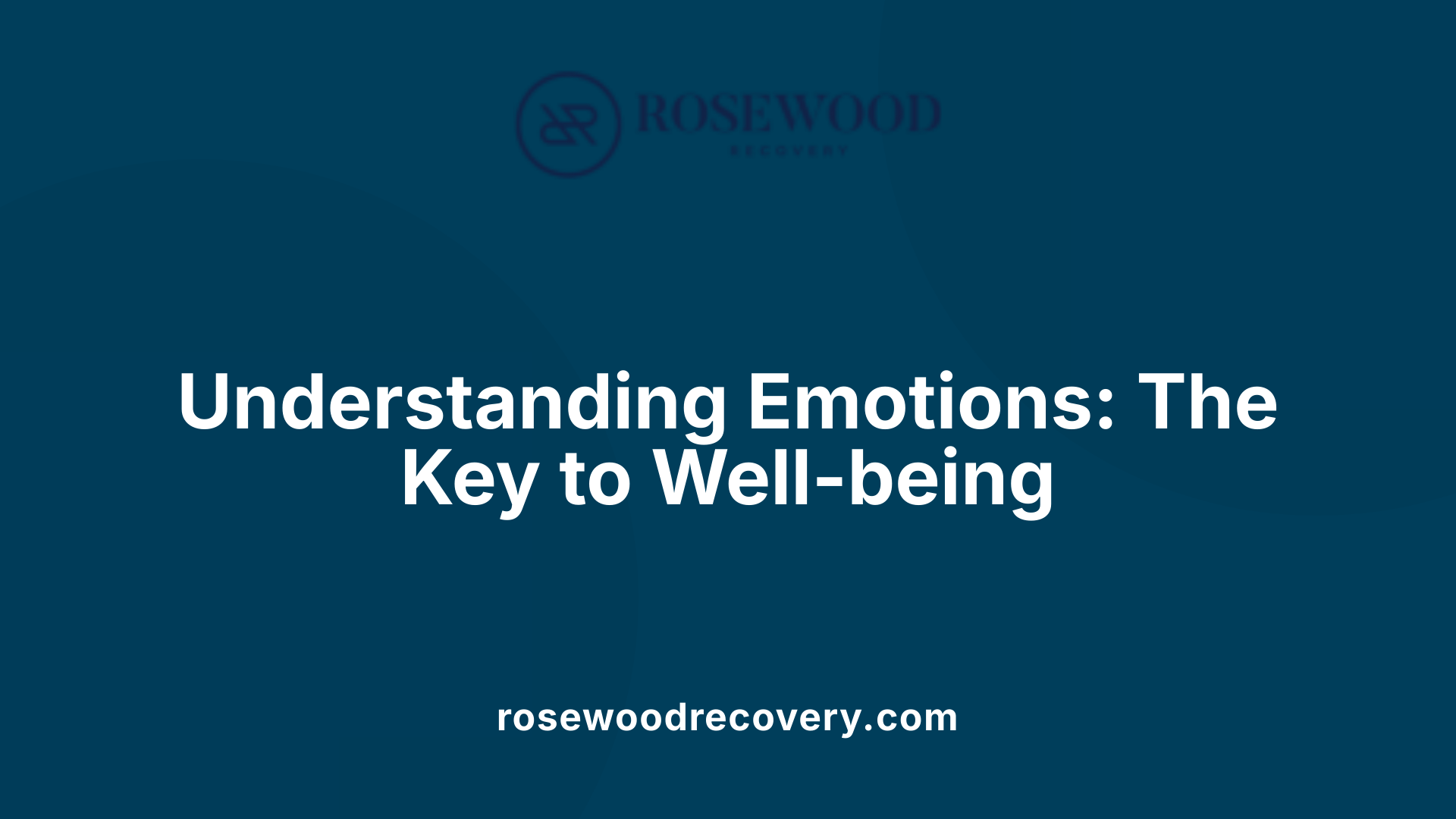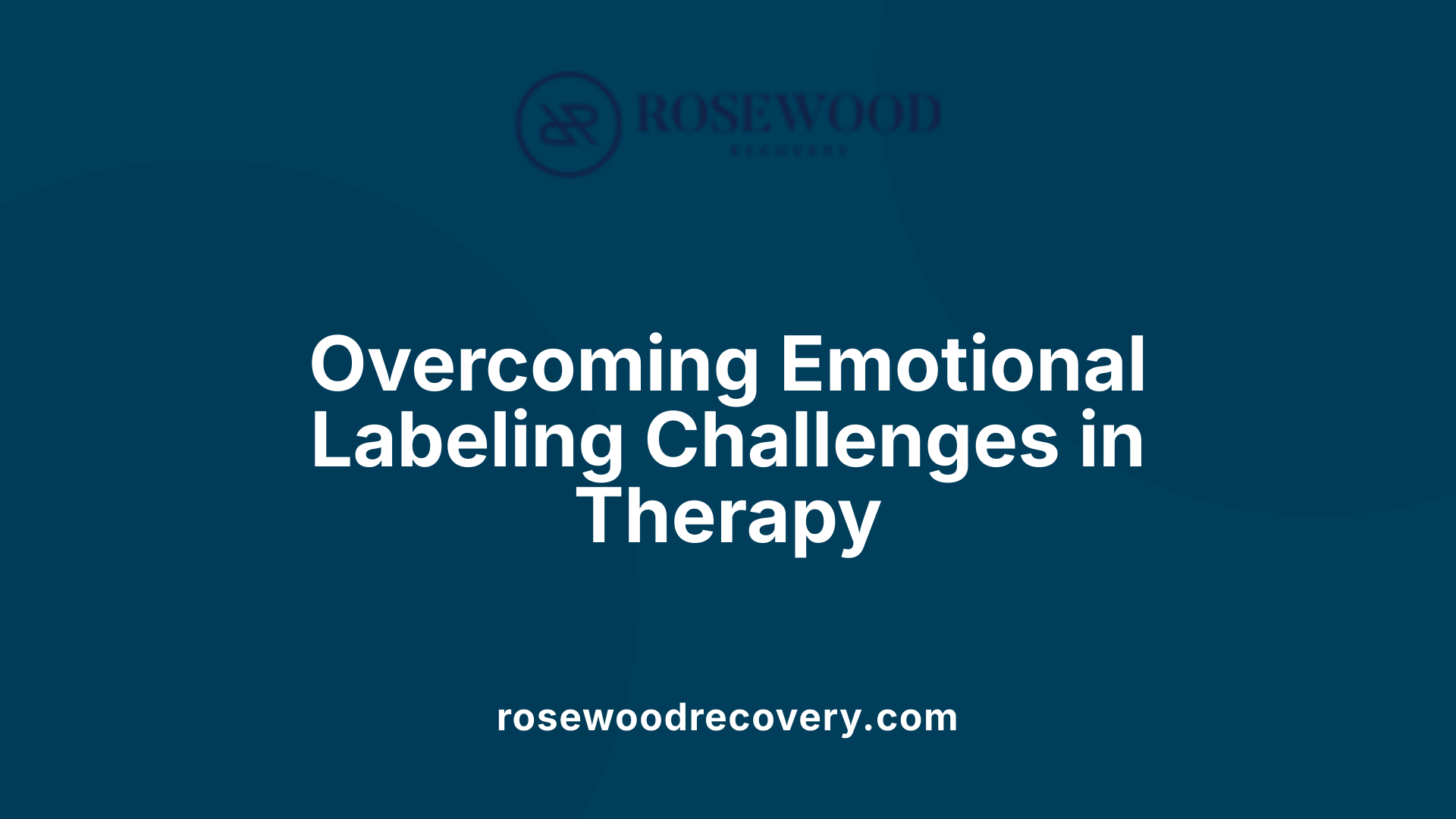Understanding Emotion Naming in Mental Health
Emotion naming is more than just putting feelings into words. In therapeutic contexts, especially in comprehensive treatment for substance abuse and mental health disorders, the ability to identify and accurately label emotions plays a critical role in emotional regulation and recovery. This article explores how naming emotions serves as a powerful tool in therapy, revealing its functions, challenges, and therapeutic benefits that contribute to improved mental health and addiction recovery outcomes.
The Fundamental Role of Emotions and the Importance of Naming Them

What Are the Functions of Emotions?
Emotions are essential signals that help us navigate life and maintain mental health. They serve three primary functions: communicating our internal states to ourselves and others, facilitating social interaction, and preparing us to take action. For example, feeling fear alerts us to potential danger and readies our body for a fight-or-flight response.
What Are Basic and Complex Emotions?
Human emotions can be grouped into broad categories such as anger, sadness, fear, happiness, disgust, love, guilt, and envy. Psychologist Paul Ekman identified six universal basic emotions seen across cultures: happiness, sadness, fear, disgust, anger, and surprise, later adding emotions like shame and pride. Beyond these basic emotions, complex feelings emerge from combinations and nuances, reflecting our unique experiences.
Why Is Specificity in Naming Emotions Important?
Being able to distinguish between subtle emotions — for example, telling the difference between irritation and fury — is crucial. Specific labeling enhances emotional regulation by allowing us to respond appropriately rather than getting overwhelmed. Naming emotions makes feelings more manageable and supports mental wellness.
What Does the Evolutionary Perspective Tell Us About Emotions?
From an evolutionary standpoint, emotions like fear have been vital for survival. They trigger reflexive responses to threats in our environment, helping ancestors avoid harm. This evolutionary heritage underlies why emotions are universal and deeply embedded in our nervous system.
In sum, understanding emotions and learning to accurately name them is not only fundamental for emotional awareness but also supports healthy regulation and social connection.
How Naming Emotions Enhances Emotional Awareness and Regulation
Emotional Awareness in Dialectical Behavior Therapy (DBT)
Naming emotions is a foundational element of Dialectical Behavior Therapy (DBT), which promotes emotional awareness as essential for improving mental health and self-regulation. DBT emphasizes recognizing and labeling feelings precisely to foster control rather than being controlled by intense emotions.
Impact of Emotion Naming on Regulation
Research shows that accurately naming emotions can reduce negative feelings by making them more manageable. When individuals distinguish between subtle differences—such as irritation versus fury—they gain greater control over their responses. This specificity enables healthier and more appropriate reactions to emotional experiences.
Use of Tools Like Emotion Wheels
Tools such as emotion wheels support the process of identifying and naming feelings by providing a visual guide to the broad categories of emotions and their more nuanced variations. These aids help individuals articulate what they are feeling, which is particularly useful in therapy or self-reflection.
Mindfulness and Emotion Identification Practices
Practicing mindfulness—paying nonjudgmental attention to present emotions—complements naming emotions by developing deeper awareness. Mindfulness paired with emotion naming encourages pausing to identify feelings, understanding their sources, and communicating them clearly, which strengthens emotional regulation over time.
Alexithymia: When Emotion Identification Breaks Down
What is Alexithymia?
Alexithymia is a condition characterized by difficulty in recognizing and describing one's own emotions. People with alexithymia struggle to identify their feelings accurately, which affects emotional processing and communication.
What Are the Components of the Emotional Identification Model?
Understanding emotion identification involves seven components:
- Baseline mood: The underlying emotional state.
- Monitoring: Observing emotional changes.
- Physiological responses: Body signals linked to emotions.
- Interoception: Internal perception of bodily sensations.
- Context: Situational awareness influencing emotion.
- Metacognition: Thinking about one's emotional state.
- Labeling: Assigning specific names to emotions.
Deficits in any of these areas can contribute to alexithymia, making it challenging to process emotions.
How Is Alexithymia Linked to Mental Health Disorders?
Alexithymia is strongly associated with a broad range of mental health conditions, including:
| Disorder | Description |
|---|---|
| Depression | Mood disorder characterized by persistent sadness and loss of interest. |
| Anxiety disorders | Disorders involving excessive fear or worry. |
| Substance use disorders | Problems related to the harmful use of drugs or alcohol. |
| Eating disorders | Abnormal eating habits impacting health. |
| Autism | Neurodevelopmental disorder affecting communication and behavior. |
| Psychosomatic disorders | Physical illnesses influenced by emotional factors. |
This overlap highlights the clinical importance of addressing emotion recognition issues.
How Does Alexithymia Affect Therapy Effectiveness?
Therapies such as Cognitive Behavioral Therapy (CBT) and Dialectical Behavior Therapy (DBT) rely on patients’ ability to identify and label emotions. When individuals have alexithymia, these techniques may become less effective because:
- They cannot accurately recognize emotional cues.
- Emotional labeling and awareness are impaired.
- Processing feelings needed for cognitive restructuring is hindered.
Therefore, therapies may need adaptation to include emotion naming tools and strategies to improve emotional awareness.
Improving emotional identification skills can significantly enhance treatment outcomes by fostering better emotional regulation and promoting recovery.
The Connection Between Emotion Identification and Addiction Recovery
What is the role of emotional regulation in addiction recovery?
Emotional regulation is vital in addiction recovery as it helps individuals manage intense emotions without resorting to substance use. Effective regulation lowers the risk of cravings and relapse by enabling better coping with emotional triggers and co-occurring mental health disorders. Techniques such as Dialectical Behavior Therapy (DBT), Cognitive Behavioral Therapy (CBT), mindfulness, and expressive arts therapy support the development of healthier emotional responses.
Why do individuals in recovery struggle with identifying emotions?
Many individuals in recovery face difficulties in accurately naming and recognizing emotions, often due to prolonged emotional suppression or numbing during active addiction. This struggle impairs emotional regulation and can hinder therapeutic progress. Using tools like emotion wheels, mindfulness practices, and emotion charts assists in improving emotional literacy.
How does long-term substance use affect emotional regulation?
Chronic drug or alcohol use impairs brain mechanisms involved in emotion identification and management. This creates a cycle where emotional dysregulation drives substance use, and substance use further worsens emotional control. Such impairments are linked with disorders including depression, anger, and aggression—conditions commonly co-occurring with addiction.
Why is emotional literacy important for maintaining sobriety?
Developing emotional literacy—understanding and labeling specific emotions—allows individuals to respond thoughtfully rather than impulsively. It enhances self-awareness and resilience, which are critical in managing stress and avoiding relapse. Practicing emotional naming and regulation techniques promotes healthier coping strategies and supports long-term recovery.
| Aspect | Description | Impact on Recovery |
|---|---|---|
| Emotional Regulation | Managing emotions using therapy and mindfulness | Reduces relapse risk, improves coping skills |
| Emotion Identification | Recognizing and naming feelings | Enables targeted emotional responses |
| Substance Use Effects | Impairment of emotional control mechanisms | Creates a cycle of dysregulation and addiction |
| Emotional Literacy | Awareness and understanding of emotions | Supports resilience and sustained sobriety |
Therapeutic Techniques to Enhance Emotion Naming and Regulation
How does DBT promote mindfulness and distress tolerance?
Dialectical Behavior Therapy (DBT) emphasizes mindfulness and distress tolerance to help individuals manage intense emotions and reduce impulsive reactions. Mindfulness encourages present-moment awareness without judgment, allowing individuals to recognize their emotions as they arise. Distress tolerance skills teach coping strategies to endure and survive emotional crises without resorting to harmful behaviors.
What role does Cognitive-Behavioral Therapy (CBT) play?
CBT helps individuals identify and reframe negative thought patterns that contribute to emotional dysregulation. By labeling and challenging distorted thoughts, CBT fosters clearer emotional understanding and healthier responses to stressors. It supports relapse prevention by addressing emotional triggers and promoting adaptive behaviors.
How are Expressive Arts Therapy and Emotion-Focused Therapy (EFT) used?
Expressive Arts Therapy encourages creative expression to explore and articulate emotions that may be difficult to identify verbally. Emotion-Focused Therapy (EFT) directly targets emotional awareness and processing, helping clients experience and regulate their feelings effectively. Both therapies enhance emotional literacy through experiential approaches.
How do emotion charts and facial expression tools aid emotion naming?
Therapists often use emotion charts featuring various facial expressions and emotion words to assist patients in recognizing and naming feelings, especially those linked to trauma or alexithymia. These visual aids provide concrete references that improve accuracy in identifying subtle or complex emotions.
What benefits do journaling and meditation offer as coping strategies?
Journaling provides a reflective space to track emotions, explore triggers, and practice naming specific feelings daily. Meditation supports emotional regulation by fostering calmness, reducing stress, and promoting mindful awareness. Together, these practices build emotional insight and resilience over time.
By integrating these techniques, individuals can develop improved emotional awareness and regulation skills, contributing significantly to better mental health outcomes and sustained recovery.
The Impact of Emotion Naming on Trauma Recovery
How Does Naming Emotions Contribute to Trauma Therapy?
Naming emotions is a fundamental practice in trauma therapy that fosters emotional awareness and understanding. By putting labels on feelings, individuals gain clarity about their internal experiences, which helps lessen the overwhelming nature of trauma-related emotions. Recognizing specific emotions enables patients to engage more actively in their recovery process instead of feeling engulfed by undefined emotional states.
How Does Awareness Reduce Emotional Intimidation?
Identifying and naming emotions reduces their intimidating quality by making feelings more accessible and manageable. When people become aware of what they are experiencing, they gain a sense of control that supports emotional regulation. This awareness helps disarm the fear or confusion often sparked by trauma, allowing individuals to face their feelings with greater courage and less distress.
How Are Emotion Charts Used in Trauma Recovery?
Therapists frequently incorporate emotion charts featuring facial expressions and emotional terms to assist patients in recognizing difficult emotions. These visual tools serve as guides that aid in pinpointing emotions that may be complex or unsettling, especially when trauma impairs emotional clarity. Using charts can improve communication between therapists and clients by establishing a shared emotional vocabulary.
Why Is Processing Trauma-Related Emotions Important for Healing?
Processing trauma-related emotions through naming is essential for emotional integration and healing. As individuals identify and articulate their feelings, they move beyond avoidance and suppression, which are common barriers to recovery. This process helps in transforming distressing emotions into manageable experiences, promoting psychological resilience and facilitating progression toward recovery goals.
Integrating Emotion Naming in Mental Health and Addiction Treatment Programs

Adaptation of DBT Skills Training in Co-Occurring Disorders
Dialectical Behavior Therapy (DBT) is extensively adapted within treatment programs for individuals experiencing both mental health and substance use disorders. Programs like AAC’s CARE emphasize DBT skill training to enhance emotional awareness and regulation, particularly for addressing the complex needs of co-occurring disorders. By focusing on mindfulness, distress tolerance, and interpersonal effectiveness, DBT facilitates improved emotional stability and helps patients navigate triggers related to addiction and mood disturbances.
Comprehensive Approaches Addressing Emotional Regulation
Effective mental health care incorporates a range of behavioral therapies alongside emotion naming techniques. Cognitive Behavioral Therapy (CBT), Emotion-Focused Therapy (EFT), and expressive arts therapies complement DBT by teaching patients to recognize, label, and process emotions accurately. These treatments reduce reliance on maladaptive coping strategies such as substance misuse and support healthier emotional processing.
Relationship Between Depression, Anger, and Addiction
Emotional dysregulation plays a pivotal role in the links between depression, anger, and addiction. Individuals struggling with mood disorders like major depression or bipolar disorder frequently experience difficulty identifying and managing emotions, increasing the risk of substance misuse. Integration of emotion naming and regulation skills in treatment programs helps address this cycle by improving emotional insight and reducing relapse.
Behavioral Therapies Targeting Emotional Regulation and Interpersonal Skills
Behavioral therapies embedded within recovery efforts focus on reshaping harmful thought patterns and improving emotional management. Techniques that enhance interpersonal skills and emotional regulation are essential components of integrated programs, as they directly address the emotional challenges that fuel addiction and mental health symptoms. Emotion naming improves self-awareness, enabling individuals to respond thoughtfully rather than react impulsively, fostering sustained recovery and healthier relationships.
Challenges and Barriers to Effective Emotion Identification in Therapy

Difficulties with Emotion Labeling in Some Populations
Certain individuals struggle to accurately identify and name their emotions, a challenge particularly prominent in populations with alexithymia. This condition impairs the ability to recognize and describe feelings, affecting mental health and therapy outcomes.
Impact of Alexithymia on CBT and DBT Outcomes
Alexithymia presents a significant barrier in therapies like Cognitive Behavioral Therapy (CBT) and Dialectical Behavior Therapy (DBT), which rely heavily on emotional awareness and labeling. Without accurate emotion identification, these therapies may be less effective, as patients find it difficult to engage in reappraisal and regulation of their emotional experiences.
Maladaptive Emotional Regulation Strategies Like Suppression
When individuals cannot name their emotions clearly, they often resort to maladaptive strategies such as emotional suppression or avoidance. These responses hinder therapeutic progress and may exacerbate underlying mental health disorders.
Therapeutic Adjustments to Overcome Emotional Identification Deficits
To address these challenges, therapists often use tools like emotion charts with facial expressions and emotion wheels to support patients in recognizing and labeling emotions. Mindfulness practices and gradual skill-building in emotional awareness help bridge gaps in emotional identification. Tailoring interventions to focus on enhancing emotion labeling can improve therapy engagement and outcomes, especially in trauma recovery and addiction treatment contexts.
Practical Steps for Practitioners to Foster Emotional Naming Skills

Guiding clients in pausing and identifying emotions
Practitioners can help clients develop emotional naming skills by encouraging them to pause during moments of emotional intensity. This break allows individuals to step back from overwhelming feelings and begin the process of identifying what they are truly experiencing. Encouraging clients to explore specific feelings rather than general categories improves emotional clarity and regulation.
Utilizing mindfulness and emotion wheels
Mindfulness is a foundational tool in building emotional awareness. Practitioners should guide clients to practice observing emotions without judgment, which increases their sensitivity to subtle emotional shifts. Using emotion wheels—visual aids presenting a range of emotions and their nuances—can facilitate more precise labeling, moving clients beyond broad feelings like "anger" to more nuanced ones such as "irritation" or "fury."
Encouraging clear emotional communication
Effective communication of emotions is crucial for healthy interpersonal relationships and therapy progress. Teach clients to articulate their feelings clearly, fostering openness and reducing misunderstandings. This can be practiced through role-playing or journaling exercises where clients describe their emotions vividly and specifically.
Strategies for developing emotional self-awareness
Developing self-awareness requires a stepwise approach including:
- Monitoring baseline moods and physiological responses
- Practicing interoception to tune into bodily sensations linked to emotions
- Reflecting on context and triggers
- Engaging metacognition to observe thoughts about feelings
- Labeling emotions accurately These steps mirror components of emotion identification models and help individuals overcome difficulties such as alexithymia, thereby enhancing emotional literacy.
By combining these practical techniques, practitioners can empower clients to name and manage emotions effectively, supporting improved mental health and emotional regulation outcomes.
Benefits of Emotional Regulation Through Naming Emotions in Sustaining Recovery

How does naming emotions reduce the risk of relapse?
Naming emotions enhances emotional regulation, which is crucial in addiction recovery. When individuals can identify and label their feelings, they can better manage emotional triggers that often lead to cravings. Recognizing these feelings early allows them to implement coping strategies such as mindfulness or distress tolerance, reducing the chances of relapse.
In what ways does emotional regulation help manage cravings and triggers?
Effective emotional regulation helps individuals pause and respond to cravings instead of reacting impulsively. Techniques taught in therapies like Dialectical Behavior Therapy (DBT) include distress tolerance and delayed gratification, which empower recovering individuals to face uncomfortable emotions without seeking substances. Managing emotional responses also supports handling co-occurring mental health disorders that can trigger relapse.
How does emotional regulation contribute to building emotional resilience and self-confidence?
By learning to name and regulate emotions, people strengthen their emotional resilience—the ability to recover from stress and setbacks. This process boosts self-confidence, as individuals gain control over their emotional state rather than being overwhelmed. Such progress supports sustained recovery by reducing emotional avoidance and promoting healthier coping mechanisms.
What are the effects of improved emotional regulation on relationships and mental clarity?
Accurate emotion naming improves communication and interpersonal effectiveness, which enhance relationships during recovery. Clear understanding of personal feelings also fosters mental clarity, reducing stress and confusion. These improvements create a stable emotional environment conducive to long-term sobriety.
| Benefit | Description | Therapeutic Approach Examples |
|---|---|---|
| Reduced relapse risk | Managing emotional triggers diminishes cravings and impulsive use | DBT, CBT, Mindfulness |
| Effective craving management | Using distress tolerance to face uncomfortable emotions | Dialectical Behavior Therapy (DBT) |
| Increased emotional resilience | Building confidence in handling stress and setbacks | Expressive Arts Therapy, Meditation |
| Enhanced relationships and clarity | Clear communication and reduced stress improve social support mechanisms | Interpersonal Effectiveness Training |
Supporting Emotional Regulation During High-Stress Periods and Long-Term Recovery
Why Is Naming Emotions Important in Managing Stress?
Naming emotions is a fundamental step in emotional regulation, especially during stressful times like holidays or challenging phases of recovery. When people accurately identify and label their emotions, such as distinguishing irritation from anger, it makes feelings more manageable and less overwhelming. This practice helps individuals pause, understand their inner state, and choose healthier responses rather than reacting impulsively or suppressing emotions.
How Can Self-Care Practices Like Yoga and Meditation Help?
Self-care activities such as yoga, meditation, and deep breathing are effective tools to support emotional regulation. These methods promote mindfulness and reduce stress, enabling individuals to calm their physiological responses and sustain emotional clarity. Regular practice helps build resilience by improving awareness of bodily sensations and emotional states, making it easier to face feelings without judgment.
What Challenges Does Emotional Dysregulation Present During the Holidays?
The holidays often come with increased stress, interpersonal strain, and emotional triggers that can challenge even those with well-developed coping skills. Emotional dysregulation during these periods can lead to heightened reactivity, irritability, or relapse risks for individuals in recovery. Practicing emotional identification and regulation techniques during high-stress moments reduces emotional overwhelm and supports steadier mood regulation.
When Should Professional Help Be Sought for Emotional Difficulties?
Difficulty recognizing and managing emotions is common but can sometimes require professional support. Therapists use strategies such as Dialectical Behavior Therapy (DBT) to teach emotional awareness, distress tolerance, and healthy communication. Seeking help is crucial for people struggling with persistent emotional challenges or co-occurring mental health and substance use disorders, facilitating sustainable recovery and improved quality of life.
| Strategy | Description | Benefit |
|---|---|---|
| Emotion Naming | Identifying specific feelings (e.g., frustration vs. anger) | Enhances clarity and control over emotions |
| Mindfulness & Yoga | Focused breathing and physical movement | Reduces stress and improves emotional balance |
| Professional Therapy | Guided support using methods like DBT or CBT | Builds lasting coping skills and emotional insight |
| Self-Monitoring | Using journals or emotion wheels | Increases awareness and helps track emotional patterns |
Harnessing the Power of Emotion Naming for Mental Health and Recovery
Naming emotions is a transformative skill that enhances emotional awareness, supports healthier coping mechanisms, and strengthens recovery from addiction and mental health disorders. Through therapeutic techniques emphasizing emotional identification and regulation, individuals can gain control over their feelings rather than being overwhelmed by them. This process is crucial not only in trauma recovery but also in managing co-occurring disorders and preventing relapse. As therapy continues to integrate practices that cultivate emotion naming, the potential for lasting mental health improvements and sustained sobriety grows stronger, highlighting the profound power embedded in simple words.
References
- Naming Emotions DBT Skill: Key to Emotional Health & ...
- The process of emotion identification: Considerations for ...
- Naming Emotions Helps Us Experience Them
- 5 Ways to Identify Your Emotions
- Emotional Regulation in Addiction Treatment at Antrim, NH
- Emotional Regulation in Recovery | Addiction Treatment
- The Role of Emotions in Recovery and Treatment
- The process of emotion identification: Considerations for ...
- The Importance of Emotional Regulation in Recovery




